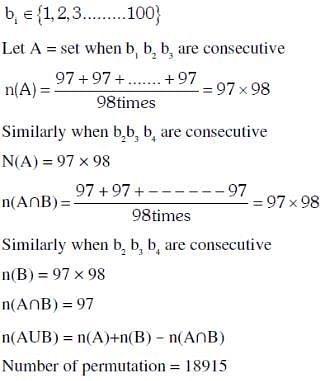Maths Unit Test: Permutations & Combinations(June 28) - JEE MCQ
15 Questions MCQ Test Daily Test for JEE Preparation - Maths Unit Test: Permutations & Combinations(June 28)
A class contains b boys and g girls. If the number of ways of selecting 3 boys and 2 girls from the class is 168, then b + 3 g is equal to ____. (in integers)
The number of words (with or without meaning) that can be formed from all the letters of the word "LETTER" in which vowels never come together is ________. (in integers)
| 1 Crore+ students have signed up on EduRev. Have you? Download the App |
If the letters of the word 'MOTHER' be permuted and all the words so formed (with or without meaning) be listed as in a dictionary, then the position of the word 'MOTHER' is _______. (in integers)
The number of six-letter words (with or without meaning), formed using all the letters of the word 'VOWELS', so that all the consonants never come together, is ______. (in integers)
If the digits are not allowed to repeat in any number formed by using the digits 0, 2, 4, 6, 8, then the number of all numbers greater than 10,000 is equal to _______. (in integers)
If a, b and c are the greatest values of 19Cp, 20Cq and 21Cr respectively, then
In an examination, there are 5 multiple choice questions with 3 choices, out of which exactly one is correct. There are 3 marks for each correct answer, -2 marks for each wrong answer and 0 marks if the question is not attempted. Then the number of ways a student appearing in the examination gets 5 marks is _____. (in integer)
Let b1b2b3b4 be a 4-element permutation with bi ∈ {1, 2, 3, ..., 100} for 1 ≤ i ≤ 4 and bi ≠ bj for i ≠ j, such that either b1, b2, b3 are consecutive integers or b2, b3, b4 are consecutive integers.
Then the number of such permutations b1b2b3b4 is equal to _________. (in integers)
Total number of 6-digit numbers in which only and all the five digits 1, 3, 5, 7 and 9 appear, is
The total number of three-digit numbers, with one digit repeated exactly two times, is ______. (in integers)
Let denote nCk and
.
If Ak = and A4 - A3 = 190 p, then p is equal to __________. (in integers)
The number of ways, 16 identical cubes, of which 11 are blue and rest are red, can be placed in a row so that between any two red cubes there should be at least 2 blue cubes, is _______. (in integers)
The number of 5-digit natural numbers, such that the product of their digits is 36, is _____ . (in integers)
An urn contains 5 red marbles, 4 black marbles and 3 white marbles. Then the number of ways in which 4 marbles can be drawn so that at the most three of them are red is _________. (in integers)
Let n > 2 be an integer. Suppose that there are n Metro stations in a city located along a circular path. Each pair of stations is connected by a straight track only. Further, each pair of nearest stations is connected by blue line, whereas all remaining pairs of stations are connected by red line. If the number of red lines is 99 times the number of blue lines, then the value of n is:
|
360 tests
|



















